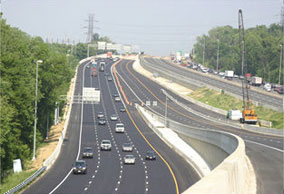Springfield Interchange - VA
FAST FACTS ABOUT: Springfield Interchange - VA
Types of TDM: Mode Choice, Route Choice, Trip Substitution
Choice
Keywords: reconstruction, HOV, retail information center,
park and ride, commuter rail
Program: TDM Program as part of Congestion Management
Plan for the Springfield Interchange Improvement Project.
Cost of Program: $10 million for TDM program over 8
years
Contact: Valerie Pardo, Virginia Department of Transportation

Area Characteristics
The Springfield Interchange Improvement Project, a major reconstruction
project sponsored by the Virginia Department of Transportation (VDOT),
is currently mid-way through construction. The multi-phased, $350 million
project began in March of 1999 and is scheduled for completion in 2007.
The pre-project interchange, where I-95, I-395 and I-495 met, was nearly
a mile long linking the three major interstates and serving nearly 400,000
vehicles a day. The original interchange was constructed in the 1960’s
and was not equipped to handle current or future transportation needs.
Traffic forecasts projected volumes to double by 2020. Project improvements
include building more than 50 bridges and flyovers, 30 ramps, and installing
nearly 200 guide signs and 20 electronic message signs. Among a number
of goals, VDOT undertook the Project to improve safety and access while
increasing throughput capacity. A main project feature is to barrier-separate
HOV lanes, through lanes and local lanes on I-95 to reduce weaving conflicts.
Program Description
VDOT has worked with federal and local agencies to create a comprehensive
Congestion Management Plan ($28 million) including incident management,
traffic operations, and demand management. The program allocation is
$10 million over 8 years. Specific Plan goals were established to reduce
1,000 vehicles per peak hour and 2,500 vehicles per peak period.

Incident management components include the use of an on-site mobile
command vehicle, equipment to respond to hazardous waste spills and
traffic incidents of all degrees as well as increased patrols by the
police and safety service units. Operational improvements include the
installation of cameras to monitor traffic flow proximate to the interchange,
a coordinated construction phasing plan, and information dissemination
regarding alternate routes and emergency routes. In addition, signal
timing adjustments and spot intersection improvements (installing or
lengthening turn pockets) were also made. Infrastructure improvements
also included capacity enhancements at intersections along parallel
routes to accommodate diverted trips. Other specific TDM investments
included a 10% increase in Park & Ride spaces, expanded commuter
rail service, OmniRide bus enhancements, telework centers, fare discounts
for both bus and rail service, and the promotion of vanpools, carpools,
and private buspools of more than 30 passengers.
The region has numerous transportation management associations (TMA)s
and ridesharing organizations available to users. Currently, bus service
proximate to Springfield is free of charge thanks to a state-funded
program conceived by the Northern Virginia Transportation Commission,
Fairfax County, and the Washington Metropolitan Area Transit Authority
(WMATA).
The Project maintains a project website, an information line and utilizes
media for public outreach. Commuters or other travelers are encouraged
to stay informed about project conditions. VDOT has enhanced information
dissemination to the public by opening the nation’s first formalized
retail Information Center (IC), which is located in the Springfield
Mall to help disseminate project information. The storefront station
is equipped with monitoring cameras and can provide rideshare assistance
and transit information and passes. Additional project elements promoting
TDM include High Occupancy Vehicle (HOV) lanes, including the two-lane
reversible facility running north to south and roadway operational improvements.
Measures of Effectiveness
The use of transit, carpooling, and vanpooling in the I-405 corridor
has been consistently high due in large part to the success of the HOV
lanes and Metrorail line. The challenge of the Congestion Management
Plan was to provide additional services that would encourage drivers
to change their behaviors. An early survey of single occupant drivers
determined the most effective improvements to entice people out of their
cars. Demand-side strategies were formulated based on these improvements.
With HOV lanes already in place, VDOT was able to offer a time-savings
advantage. The public outreach component is proving to be a success.
As of May 2003, over 230,000 motorists had visited the Information Center
in the Springfield Mall.
The Springfield Interchange Improvement Project is currently in Phase
4 and 5 and continues to operate the Congestion Management Plan established
for the Project. As of June 2002, the Congestion Management Plan had
been through three evaluation processes and has not been substantially
modified. Minor shifts in programmed funds have occurred, but the majority
of demand-side strategies are performing at or above their anticipated
goals. Even during reconstruction, the original number of through travel
lanes is maintained during peak hours.